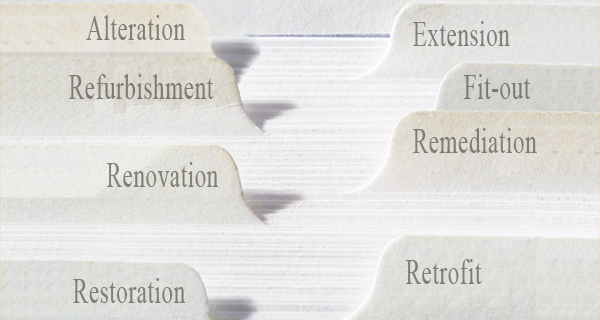Types of work to existing buildings
Contents |
[edit] Introduction
There are a number of different types of works that can be carried out on existing buildings. Some of these, the differences between them, and links ot additional information are set out below:
[edit] Alteration
Alteration is work intended to change the function or appearance of a building.
For more information see: Alteration.
[edit] Extension
Extension is the process of adding new space to a building to house additional accommodation.
For more information see: Building extension.
[edit] Fit-out
To fit-out is to provide something (or someone) with the necessary equipment or other items (clothes for people) for a particular situation or context.
For more information see: Fit out of buildings.
[edit] Refurbishment
Refurbishment is the process of improvement by cleaning, decorating and re-equipping. It may also include elements of retrofitting.
For more information see: Refurbishment.
[edit] Remediation
Remediation is the process of rectifying defects.
For more information see: Remediation.
[edit] Renovation
Renovation is the process of returning to a good state of repair - improving or modernising an old, damaged or defective building.
For more information see: Renovation.
[edit] Repurposing
Repurposing, sometimes referred to as adaptive re-use means simply to adapt something for re-use or for a new use.
For more information see: Repurposing.
[edit] Restoration
Restoration is the process of returning a building to its former state. Restoration work is most commonly undertaken on historic buildings; accurately recreating their form, features and character as they appeared at a particular time, while protecting heritage value. Decay or alterations made to a building can be reversed as part of restoration works.
For more information see: Restoration.
[edit] Retrofit
Retrofitting is providing a building with a component or feature not originally fitted. It is often used in relation to the installation of new building systems, such as heating systems, but it might also refer to the fabric of a building.
For more information see: Retrofit.
[edit] Change of use
The Town and Country Planning (Use Classes) Order categorises uses of land and buildings. Developments may not be used for purposes that are not within the use class for which they received planning permission. Changing the use of a development from one class to another may require planning permission.
For more information see: Change of use.
[edit] Deconstruction
Deconstruction is ‘construction in reverse’. As construction involves assembling and erecting buildings, so deconstruction is the complete opposite: it involves taking buildings apart piece by piece, avoiding damage to the components.
For more information see: Deconstruction.
[edit] Demolition
Demolition refers to the destruction of buildings and other artificial structures.
For more information see: Demolition.
[edit] Related articles on Designing Buildings
- Alterations to existing buildings.
- Do the building regulations apply to works to existing buildings?
- Demolition.
- Material amendment.
- Material change of use.
- Minor material amendment.
- Non material amendment.
- Change of use class.
- Planning permission.
- Permitted development.
- Renovation v refurbishment v retrofit.
- Typologies.
About the wiki
Anyone is welcome to use and contribute to the wiki in different ways.
[edit] Engaging with the wiki
You can:
- Contribute to existing articles
- Create articles
- Share articles through social media and other channels
- Contact the CIRCuIT project to let us know what you think and how we can improve
[edit] Add your own content
To contribute to or create an article, you can follow these steps:
- Register as a user
- Read through the editorial policy and guidance on writing and contributing to articles
- See the detailed help page on tips on writing wiki articles
- Try editing a test article
- If editing an article, select 'Edit this article' underneath the article title
- If creating a new article, select 'Create an article'. In the 'Select categories' area, expand the 'Industry context' list and tag 'Circular economy' to add your article to this wiki
[edit] Who is this wiki for?
The articles contain information on implementing circular economy approaches in construction that could be relevant to:
- Architects
- Construction contractors
- Designers
- Developers, owners, investors
- Engineers
- Landowners
- Manufacturers and supplier
- Universities and research
- Urban planners
[edit] About CIRCuIT
The Circular Economy wiki is supported by the Circular Construction in Regenerative Cities (CIRCuIT) project, which is funded by the European Union's Horizon 2020 research and innovation programme. CIRCuIT is a collaborative project involving 31 ambitious partners across the entire built environment chain in Copenhagen, Hamburg, Helsinki Region and Greater London. Through a series of demonstrations, case studies, events and dissemination activities, the project will showcase how circular construction practices can be scaled and replicated across Europe to enable sustainable building in cities and the transition to a circular economy on a wider scale.








Comments
[edit] To make a comment about this article, click 'Add a comment' above. Separate your comments from any existing comments by inserting a horizontal line.